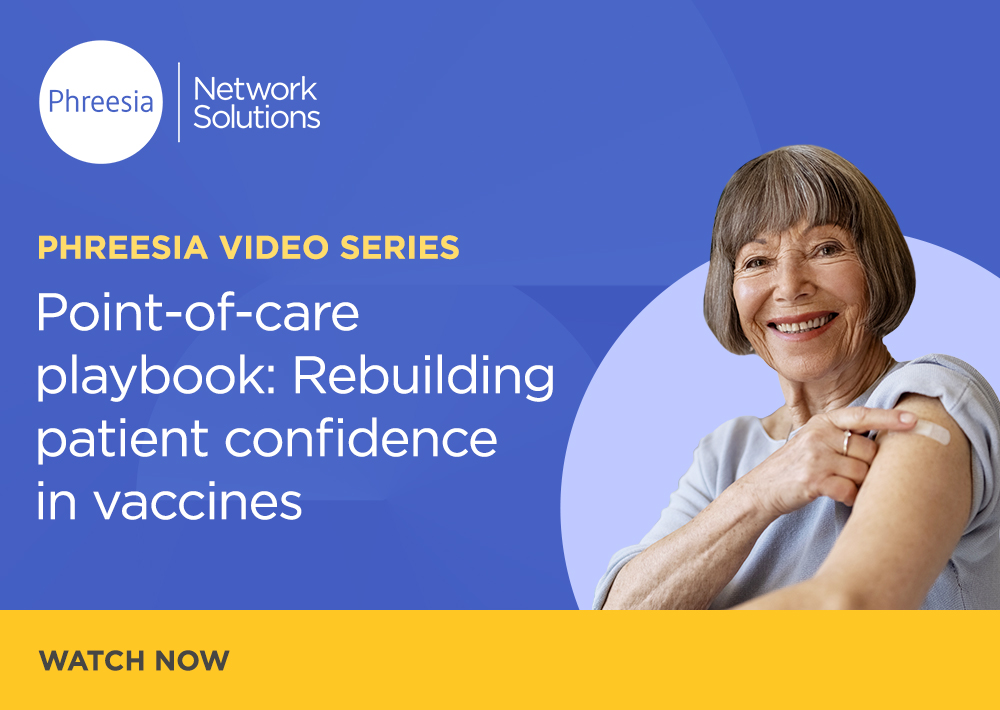
Personalized, data-driven messaging is essential for effectively engaging patients by aligning content to their specific needs, measuring meaningful outcomes and maintaining strict privacy standards.
In healthcare marketing, personalization isn’t just nice to have—it’s essential for effectively engaging patients and providers. For patients managing chronic or complex conditions, for example, receiving a message that aligns with their specific needs and experiences can be the difference between disengagement and meaningful action. At Phreesia, we’ve built our approach to consumer point-of-care messaging around this principle, using data to ensure that every message is not only seen, but also relevant and impactful.
Reaching the right patients
Every campaign we run starts with a fundamental question: Are we reaching the right patients? We constantly ask ourselves this as we define and identify the audience for each campaign. Phreesia is integrated with 80% of the U.S. electronic health record (EHR) market. That allows us to reach patients at scale, but each EHR platform categorizes and tags information differently, so it is no easy task. Phreesia’s Insights and Analytics team accesses data that has been harmonized across systems and determines who is most likely to benefit from a message. Sometimes that’s straightforward, but other times, it requires nuance. That’s where two decades of experience at this kind of personalization, having clinical experts on staff and being deeply embedded in real healthcare sets Phreesia apart.
By proactively identifying relevant diagnoses, symptoms and risk factors—even when they’re incomplete or obscured within the EHR—our team builds precise, scalable audiences that reflect real-world clinical nuance and bridge data gaps. Clinical experience tells us that patients with a specific diagnosis may experience commonly occurring symptoms associated with that condition, even if the symptom is not present within their record (perhaps because the patient was embarrassed or forgot). At other times, a patient may have been prescribed step therapies for a condition like migraine—which we can see—but we can’t see the original diagnosis. Standards of care indicate the diagnosis was made at some point, and what we can see is leagues more well-defined than nearly every other channel, even if the original diagnosis is no longer easily accessible. This approach allows us to balance precision with scale, ensuring we reach the right people without unnecessarily eliminating relevant individuals and narrowing our pool of patients. When campaigns underperform, it’s often because the audience definition was too broad or too narrow. Relevance is what drives results.
Measuring impact beyond impressions
Once a campaign is live, our focus shifts to measuring performance. We monitor monthly engagement metrics, patient survey responses and—most importantly—in-house and independent conversion analyses. These analyses compare patients who were exposed to the campaign with a control group who wasn’t, allowing us to isolate the impact of the messaging. To further flesh out our understanding of how patients are engaging with the content, we look in aggregate at whether patients requested and accessed follow-up information and whether those actions align with benchmarks for the condition area.
This kind of measurement allows us to demonstrate not just that a campaign was seen, but that it made a difference. For example:
- For many clients, the most important metric is new patient starts—that is, how many people began treatment after seeing the message. From there, we estimate return on investment (ROI) by comparing the value of those new patients to the cost of the program.
- Some clients want to know how many people were screened for cancer because of a campaign they ran on Phreesia. Using public health data about life expectancy, we can project what getting screened earlier meant in terms of people getting to live longer.
- Sometimes, we look for how many people got vaccinated and can connect that to how many illnesses the campaign helped prevent or estimated hospitalization costs eliminated.
The attribution puzzle
Of course, proving ROI is rarely simple, as Phreesia campaigns are often part of multichannel efforts. Patients in our network are exposed as consumers in their everyday lives to a wide range of marketing touchpoints: TV ads, digital banners, provider conversations. That’s why attribution remains one of the biggest challenges in healthcare marketing.
Marketing mix (MMX) models attempt to address this by estimating the contribution of each channel to overall sales gains toward goals. They are sophisticated and can be a helpful tool, but they’re far from perfect. These models take time to execute, and they often lack the granularity needed to optimize content or tactics. MMX models also often don’t take into account specific attributes of marketing platforms that set them apart. Phreesia, for example, reaches highly relevant patients at a 1:1 level, which is different than most point-of-care tactics that are office-based. This is why we recommend test control conversion studies to quantify the direct impact of the campaign on patient conversion behavior as the gold standard for assessing the benefit of the marketing activity. One additional challenge with MMX models is that they can tell us, for example, that 15% of screenings came from point-of-care messaging, but they can’t tell us which message resonated most or how to improve performance. That’s why we also rely on lift studies, directional metrics and patient surveys to provide a more complete picture. When campaigns include multiple message streams or creative refreshes, we can compare performance across segments and over time to understand what’s working—and what’s not.
Personalization that respects privacy
All the measurement methods we use put patient privacy at the forefront. For starters, when patients accept the authorization that comes before any message can be served, the authorization explains how data is used, including for measurement purposes. Patients never have to accept authorization. All patients who see messages have consented. Similarly, obtaining affirmative opt-in consent allows us to deliver personalized messaging in a way that respects patient privacy and choice.
What this means for healthcare marketers
Personalized, data-driven messaging isn’t just more engaging—it’s more effective. By aligning content with where patients are in their journey, we can help them take the next step, whether that’s starting a new treatment, talking to their doctor or simply becoming more informed. And when we measure those outcomes thoughtfully, we can demonstrate that personalization doesn’t just feel right—it delivers results.
Want to see what personalized point-of-care messaging could look like for your brand? We’d love to show you how we define audiences, measure impact and help teams move from insight to action. Request a demo today.
Karinne Smolenyak is Associate Director of Insights and Analytics at Phreesia Network Solutions. She specializes in using data to define relevant patient populations and evaluate the real-world impact of personalized point-of-care messaging.


